I’ve been working on a corset based on the 1890s corded corset pattern for Madame Ornata.
She asked me to make a BRIGHT green corset for a Victorian Poison Ivy costume. There were lots of complications (it’s complicated) and ended up going with an 18th century take on the idea for the costume party.
The brief for the corset was BRIGHT green. Unfortunately we just couldn’t find anything in visits to every fabric store in Wellington. We did pick up a cute ivy-leaf patterned green quilting fabric for the lining.
And then Madame O found the outer fabric on her own. And it was BRIGHT green. Did I tell you it was BRIGHT?
Yeah. It made the lining fabric look dull and brown.
So I had a mad rummage through my fabric stash.
I found a flowered pink cotton that was rather sweet.
Too sweet in fact. It just couldn’t stand up to the green silk.
Finally, I found a mid-pink quilting cotton.
I’m not even sure why I own this fabric. I have no idea when I acquired it. It isn’t a ‘me’ colour. It isn’t the type of fabric I sew with. And I have three or so metres of it!
But it was perfect for the green – bold enough to stand up to it, but without distracting from the green.
The pink and the green of the fabric together really reminded me of a green cymbidium orchid. So this became the Cymbidium Orchid/Poison Ivy Corset.
The first thing with the corded corset is, well, the cording.
People have been telling me that cording would be easier/work better/be more historically accurate (not for this period)/smell better etc. if I sewed the channels first, and then pulled the cords through.
It isn’t. It’s two steps instead of one. If you sew the channels tight enough to really hold the cording it is incredibly hard to pull through. And no matter how tight you sew the channels, the sew-and-then-pull-through method just doesn’t provide nearly as much support as sewn in cording. I’m not a convert.
With all the pieces corded, I sewed them together, wrong sides together, and then stitched down the seam selvedges, which would be covered with bias strips.
Along with lots and lots of cording, this corset takes lots and lots of bias strips.
Because the silk outer fabric is so lightweight, I bonded it to fusible interfacing so that the fabric would be strong enough to support the boning channels.
It would have really been smart if I had thought to bond the silk fabric to the interfacing BEFORE I cut the bias strips. And if I had noticed the obvious directionality of the silk and turned all my strips the same way.
The final challenge with this corset was the thread colours. Obviously the outer and lining fabric are very different colours. And BRIGHT green is really hard to find as a thread colour. I ended up having to use a rayon embroidery thread in bright green for the top thread. Gorgeous, but not very strong.
For strength, and because I didn’t want the contrast on the lining, I used a pink polyester thread for the bottom thread.
And, for a final touch I used brass eyelets. Green and gold are so fabulous (well, maybe not on yesterday’s Rate the Dress according to some of you).
So that’s the corset’s beginnings and a few sneak peeks to titillate you. On Saturday I’ll show you finished photos.

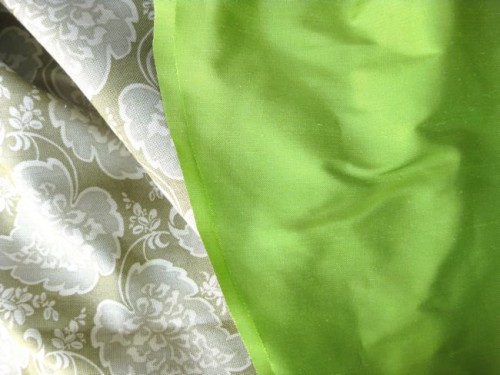

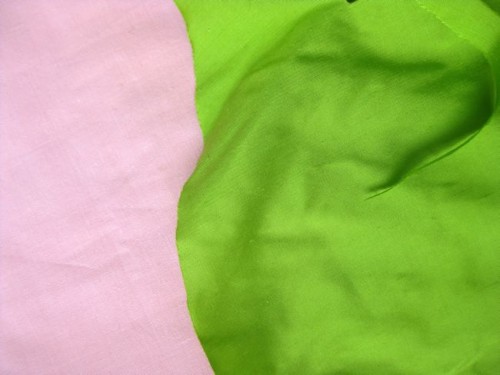


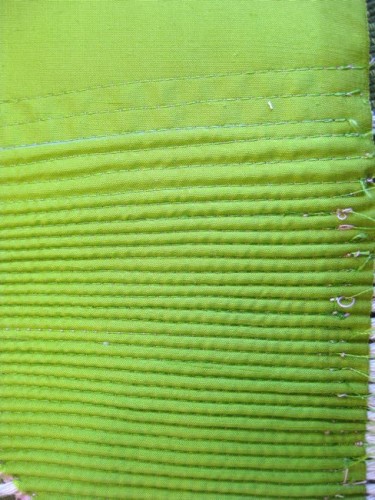
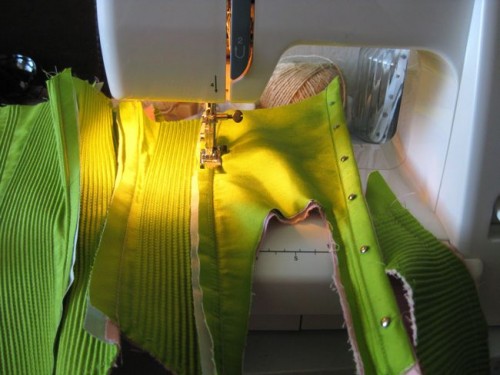
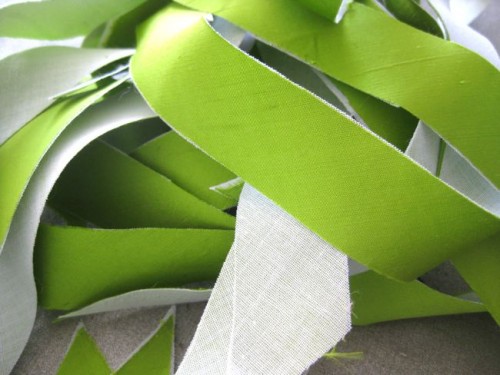

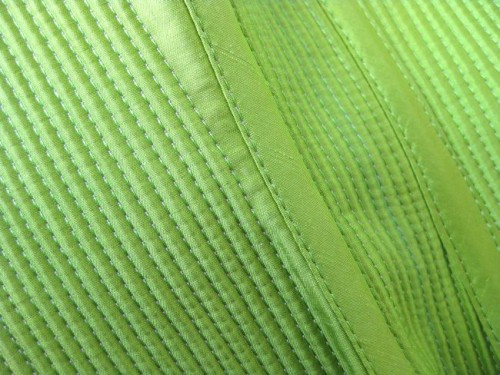

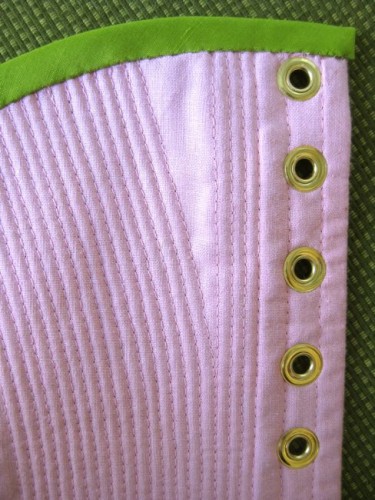
It’s so beautiful. I’m in awe of your skills…
Thank you 🙂
hempstore.co.nzIt might be a pain in the bottom, but it’s looking amazing! I love the colour. Two suggestions re. the cording:
a) What cord are you using? Looks like cotton piping cord in the photo. Allow me to suggest 3mm hemp cord from http://www.hempstore.co.nz It is much more supportive than cotton. I get very satisfactory results with it and I’m, shall we say, top heavy. With that stuff, you don’t need to sew the channels quite so tight.
b) What are you pulling it through with? If you’re not using a “needle” slightly longer than the channels made with wire or that spring stuff people hang net curtains on or similar, that will be your problem right there.
Oh, right, hemp vs. cotton! THAT’s probably the difference – I was using hemp, too.
I do plan to use a stiffer cord with future corsets, but I did try a hemp (just one available locally) for the pull through, and it flaked and was horrible and messy. I don’t like the bulkier cords over the bust as they are just so…bulky!
That’s interesting; I haven’t had any flaking with mine. I see what you mean about bulkiness over the bust. I don’t like it much either, I just accept it as a trade off because I need the support.
Little bits of your hemp cord don’t come off and splinter away? I always have that problem with hemp. The very tightly squished narrow cotton cords do a really good job of support. Madame O is rather enviably endowed.
More than a year later, I come back to add: hemp tends to expand with washing, which might be helping, too. But I agree it would not work for this style of corset, now that I’ve seen more of it.
BRIGHT!
Funnily enough, I acquired cotton thread in exactly the same bright green (at least according to my monitor) very easily when I needed it for a small project. Went to the shop and picked it. Different countries! And different shops, too, I suppose.
Oh, and MadameO’s actual Poison Ivy costume? Quoting Diana: *out of words error*!
How funny is that. I had access to every single shade of Gutterman and Metz greens, plus three other brands, and none was even close! There is a particular luminosity to the silk in person that makes it hard to match. I did have a spool of vintage thread from Nana that was close – just a tiny bit browner, but it was very small, and cording uses a LOT of thread.
Yes; it’s just luck (and still, I’m just basing it on monitor colours). I hardly have so many shades available, but luckily, the bright green was just what I needed.
Thanks for introducing me to a corset technique I was unfamiliar with. The green does look amazing especially with the texture of the cording.
Was the cording strictly for additional bust support, to replace bones? Deeply curious….
Exactly – cording provides additional support (basically, it fulfills the same functions as bones when it goes vertically), and it also helps with shaping across the bust.
Ooooh it looks spectacular, I’m looking forward to seeing the whole thing!
Thank you!
Ooh! Green! Did I mention I love green–and silk? While I peeked at the other pictures, I still can’t wait to see the pictures! I wish I could stick my head to the computer and learn your amazing skills by osmosis.
I’m glad it has a fan in you. And I’m flattered by your complements. My skills are mainly a product of lots and lots of patience and lots and lots of time. Just trying and trying and trying until I get it right.
Can’t wait to see the finished photos! It looks lovely! You do such beautiful work.
Thank you! Finished photos are coming on Sat. I’ve been good and planned ahead so that you don’t have to wait too long between progress and finish. 😀